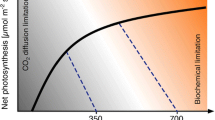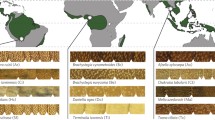Abstract
The global flask network data indicate that the temperate and boreal forests of the northern hemisphere are a significant sink for anthropogenic CO2. Bowen ratio and eddy covariance technology have been used to measure the net CO2 exchange of deciduous and coniferous forest. Some results from an earlier study on spruce with the Bowen ratio technique are presented. New technology that has been developed to measure fluxes continuously by forest stands is described and data are presented to show the net exchange flux of CO2 by temperate forests. These data support the hypothesis that temperate and boreal are forests are significant sinks for carbon dioxide. An extensive programme of experimental impact studies is being carried out by a network of 12 laboratories in Europe funded by the European Commission. Parallel studies are in progress in North America and elsewhere. These studies indicate that doubling the atmospheric CO2 concentration results in increases in tree biomass of 30–40%. Interactions with nutrition are particularly significant. If nitrogen is added at a commensurate rate, the overall effect is that trees grow larger more quickly in elevated CO2 than in ambient air but they are essentially very similar in structure and physiology. However, if nutrients are in short supply, developmental and physiological changes occur. Then elevated CO2 causes changes in dry mass allocation to roots, in phenology of bud burst and set, in photosynthesis, in respiration, and in tree water relations. These changes are exaggerated in low nutrition situations. Process-based models have been developed to scale-up from leaf and tree to the stand scale. These models contain explicit description of processes affected by CO2, and are parameterised using the data collected in the impact studies. It is concluded that forests in the temperate and boreal region can effectively contribute to the removal of anthropogenic CO2 from the atmosphere and that tree growth and production of long-lived wood products should be encouraged as a major contribution towards off-setting the greenhouse effect caused by the burning of fossil fuels.
Similar content being viewed by others
References
Barton, C.V.M., Lee, H.S.J. & Jarvis, P.G. 1993. A branch bag and CO2 control system for long term CO2 enrichment of mature Sitka spruce (Picea sitchensis (Bong.) Carr.). Plant, Cell Environ. 16: 1139–1148.
Baumgartner, A. 1956. Untersuchungen über den Wärme und Wasserhaushalt eines jungen Waldes. Ber. Dtsch. Wetterdienstes 5(28): 4–53.
D'Arrigo, R., Jacoby, G.C. & Fung, I.Y. 1987. Boreal forests and atmosphere-biosphere exchange of carbon dioxide. Nature 329: 321–323.
Denmead, O.T. 1969. Comparative micrometeorology of a wheat field and a forest of Pinus radiata. Agric. Met. 6: 357–371.
Dick, J.M.P., Jarvis, P.G. & Barton, C.V.M. 1990. Influence of male and female cones on assimilate production of Pinus contorta trees within a forest stand. Tree Phys. 7: 49–63.
Eamus, D. & Jarvis, P.G. 1989. The direct effects of increase in the global atmospheric CO2 concentration on natural and commercial temperate trees and forests. Adv. Ecol. Res. 19: 1–55.
El, Kohen, A. & Mousseau, M. 1994. Interactive effects of elevated CO2 and mineral nutrition on growth and CO2 exchange of sweet chestnut seedlings (Castanea sativa). Tree Phys. 14: 679–690.
El, Kohen, A., Rouhier, H. & Mousseau, M. 1992. Changes in dry weight and nitrogen partitioning induced by elevated CO2 depend on soil nutrient availability in sweet chesnut (Castanea sativa Mill.). Ann. Sci. For. 49: 83–90.
Enting, I.G. & Mansbridge, J.V. 1991. Latitudinal distribution of sources and sinks of CO2: results of an inversion study. Tellus 43B: 156–170.
Fung, I.Y., Tucker, C.J. & Prentice, K.C. 1987. Application of advanced very high resolution radiometer vegetation index to study atmosphere-biosphere exchange of CO2. J. Geophys. Res. 92: 2999–3015.
Grace, J.C., Jarvis, P.G. & Norman, J.M. 1987. Modelling the interception of solar radiant energy in intensively managed stands. NZ J. For. Sc. 17: 193–209.
Harmon, M.E., Ferrell, W.K. & Franklin, J.F. 1990. Effects on carbon storage of conversion of old-growth forests to young forests. Science 247: 699–702.
Hollinger, D.Y., Kelliher, F.M., Byers, J.N., Hunt, J.E., McSeveny, T.M. & Weir, P.L. 1994. Carbon dioxide exchange between an undisturbed old-growth temperate forest and the atmosphere. Ecology 75: 134–150.
Jarvis, P.G. 1981. Production efficiency of coniferous forest in the UK. In: Johnson, C.B. (ed.), Physiological Processes Limiting Plant Productivity. Butterworth Scientific Publications, London.
Jarvis, P.G. 1985. Transpiration and assimilation of tree and agricultural crops: the ‘omega factor’. In: Cannell, M.G.R. & Jackson, J.E. (eds.), Trees as Crop Plants. Institute of Terrestrial Ecology, Abbots Ripton.
Jarvis, P.G. 1993. Prospects for bottom-up models. In: Ehleringer, J. & Field, C. (eds.), Scaling Physiological Processes: Leaf to Globe. Academic Press, New York.
Jarvis, P.G. 1994. Capture of carbon dioxide by coniferous forest. In: Monteith, J.L., Scott, R.K. & Unsworth, M.H. (eds.). Resource Capture by Crops. Nottingham University Press.
Jarvis, P.G., Barton, C.V.M., Dougherty, P.M., Teskey, R.O. & Massheder, J.M. 1990. MAESTRO. In: Kiester, A.R. (ed.), Development and Use of Tree and Forest Response Models. Acidic Deposition: State of Science and Technology, Report 17. NAPAP, Government Printing Office, Washington, DC 20402–9325.
Jarvis, P.G. & Dewar, R.C. 1993. Forests in the global carbon balance from stand to region. In: Ehleringer, J.R. & Field, C.B. (eds.), Scaling Physiological Processes: Leaf to Globe. Academic Press, New York.
Jarvis, P.G., James, G.B. & Landsberg, J.J. 1976. Coniferous Forest. In: Monteith, J.L. (ed.), Vegetation and the Atmosphere Vol. 2. Academic Press, London, New York, San Francisco.
Jarvis, P.G. & Leverenz, J. 1983. Productivity of temperate, deciduous and evergreen forests. In: Lange, O.L., Nobel, P.S., Osmond, C.B. & Zeigler, H. (eds.), Encyclopedia of Plant Physiology, New Series Physiological Plant Ecology IV Vol. 12D. Springer-Verlag, Berlin.
Jarvis, P.G., Wang, Y.-P., Borhalo, N.M.G. & Pereira, J.S. 1989. Simulation of the role of stress on radiation absorption, assimilation, transpiration and water use efficiency of stands of Eucalyptus globulus. In: Pereira, J.S. & Landsberg, J.J. (eds.), Biomass Production by Fast-Growing Tree. Kluwer Academic Publishers, Dordrecht.
Lugo, A.E. & Brown, S. 1992. Tropical forests as sinks of atmospheric carbon. For. Ecol. Man. 54: 239–255.
Luxmoore, R.J., Wullschleger, S. & Hanson, P.J. 1993. Forest responses to CO2 enrichment and climate warming. Water, Air, and Soil Poll. 70: 309–323.
McMurtrie, R.E. & Wang, Y.-P. 1993. Mathematical models of the photosynthetic response of tree stands to rising CO2 concentrations and temperatures. Plant, Cell Environ. 16: 1–13.
Murray, M.B., Smith, R.I., Leith, I.D., Fowler, D., Lee, H.S.J., Friend, A.D. & Jarvis, P.G. 1994. Effects of elevated CO2, nutrition and climatic warming on bud phenology in Sitka spruce (Picea sitchensis) and their impact on frost tolerance. Tree Phys. 14: 691–706.
Price, D.T. & Black, T.A. 1990. Effects of short-term variation in weather on diurnal canopy CO2 flux and evapotranspiration of a juvenile Douglas-fir stand. Agric. For. Met. 50: 139–158.
Price, D.T. & Black, T.A. 1991. Effects of summertime changes in weather and root-zone soil water storage on canopy CO2 flux and evapotranspiration of two juvenile Douglas-fir stands. Agric. For. Met. 53: 303–323.
Tans, P.P., Fung, I.Y. & Takahashi, T. 1990. Observational constraints on the global atmospheric CO2 budget. Science 247: 1431–1438.
Thompson, D. & Matthews, R. 1989. CO2 in trees and timber lowers the greenhouse effect. For. Brit. Timber 18: 19–24.
Wang, Y.-P. & Jarvis, P.G. 1990a. Application of the model called MAESTRO to PAR absorption, photosynthesis and transpiration in Sitka spruce (Picea sitchensis (Bong.) Carr.) Tree Phys. 7: 297–316.
Wang, Y.-P. & Jarvis, P.G. 1990b. Description and validation of an array model-MAESTRO. Agric. For. Met. 51: 257–280.
Wang, Y.-P. & Jarvis, P.G. 1991. Influence of crown structural properties on PAR absorption, photosynthesis and transpiration in Sitka spruce: application of a model (MAESTRO). Tree Phys. 7: 297–316.
Wilkins, D., van, Oosten, J.J. & Besford, R.T. 1994. Effects of elevated CO2 on growth and chloroplast proteins in Prunus avium L. Tree Phys. 14: 769–779.
Wofsy, S.C., Goulden, M.L., Munger, J.W., Fan, S.-M., Bakwin, P.S., Daube, B.C., Bassow, S.L. & Bazzaz, F.A. 1993. Net exchange of CO2 in a mid-latitude forest. Science 260: 1314–1317.
Author information
Authors and Affiliations
Rights and permissions
About this article
Cite this article
Jarvis, P.G. The role of temperate trees and forests in CO2 fixation. Vegetatio 121, 157–174 (1995). https://doi.org/10.1007/BF00044681
Accepted:
Issue Date:
DOI: https://doi.org/10.1007/BF00044681




